Strategic Procurement Report: Analysis of Textile Industry Risks
VerifiedAdded on 2023/06/03
|8
|1538
|424
Report
AI Summary
This report provides a comprehensive analysis of strategic procurement within the textile industry, addressing various risks inherent in its supply chains. It begins by introducing the intricacies and dynamism of the textile business environment, particularly in emerging markets, and emphasizes the impact of fast fashion. The report then categorizes supply chain risks into several key areas, including supply management (network design, supplier relationships, selection processes, and contracts), demand management (shifting demand across time, market, and products), product management (manufacturing process complexities), and information management (strategies for fashion and functional products). Furthermore, the report delves into material flow risks, identifying operational risks (sourcing, product making, delivery, and scope), external value chain risks (partnership, financial, and information flow), and macro-environmental risks (lack of material flow, financial, and functional risks). Finally, the report concludes by summarizing the identified risks and emphasizing their implications for the textile industry, providing a foundation for understanding and mitigating these challenges.
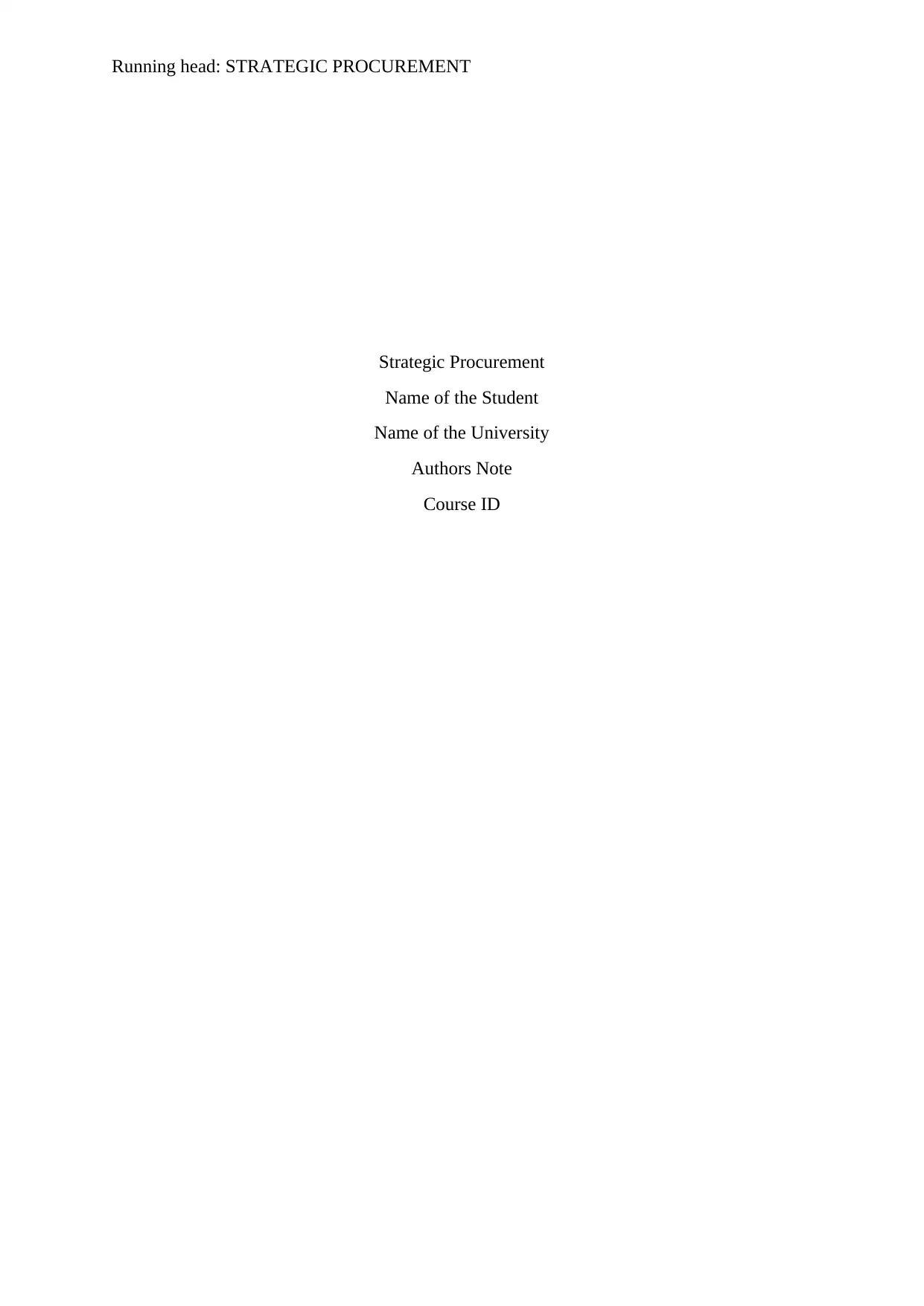
Running head: STRATEGIC PROCUREMENT
Strategic Procurement
Name of the Student
Name of the University
Authors Note
Course ID
Strategic Procurement
Name of the Student
Name of the University
Authors Note
Course ID
Paraphrase This Document
Need a fresh take? Get an instant paraphrase of this document with our AI Paraphraser
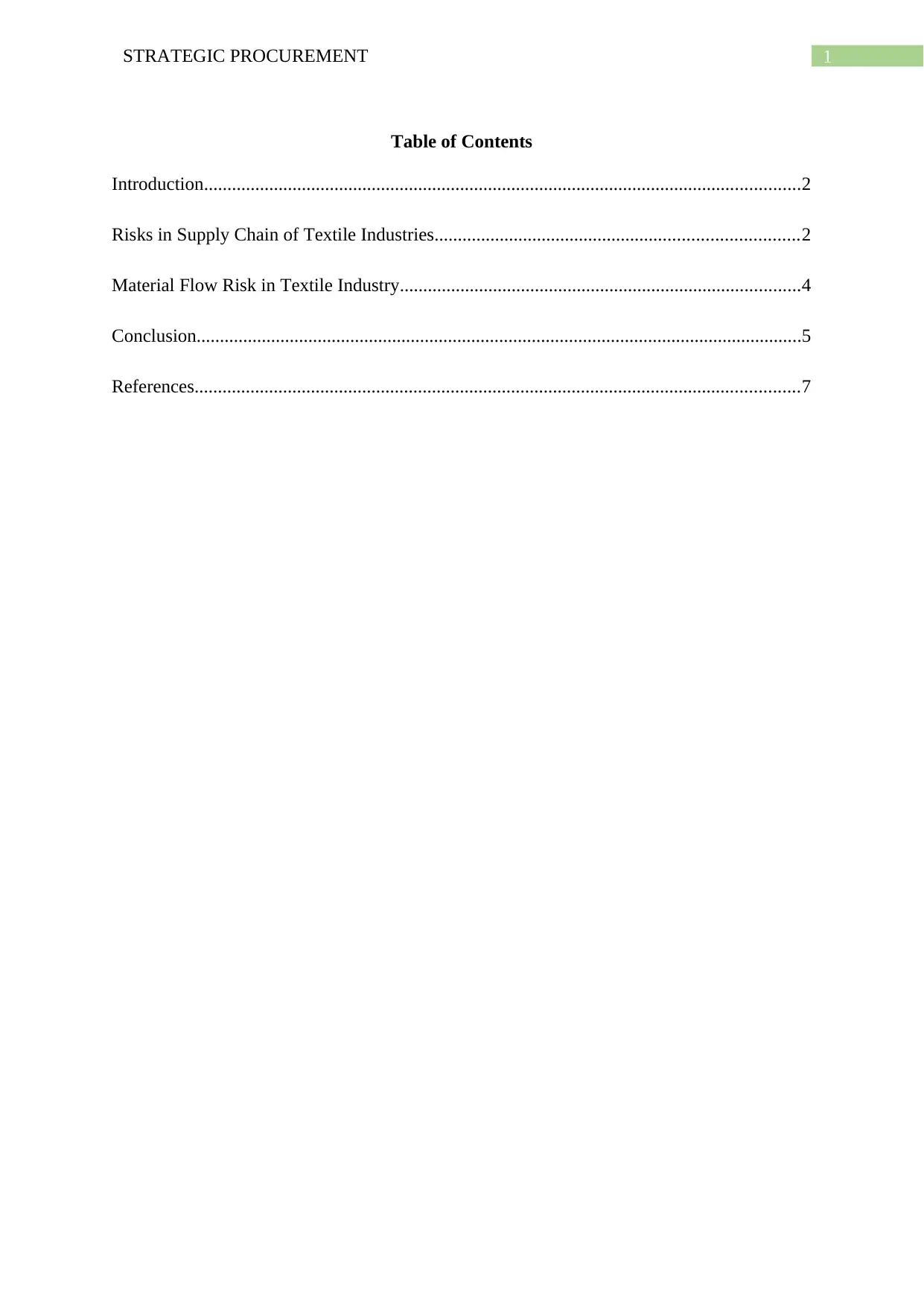
1STRATEGIC PROCUREMENT
Table of Contents
Introduction................................................................................................................................2
Risks in Supply Chain of Textile Industries..............................................................................2
Material Flow Risk in Textile Industry......................................................................................4
Conclusion..................................................................................................................................5
References..................................................................................................................................7
Table of Contents
Introduction................................................................................................................................2
Risks in Supply Chain of Textile Industries..............................................................................2
Material Flow Risk in Textile Industry......................................................................................4
Conclusion..................................................................................................................................5
References..................................................................................................................................7
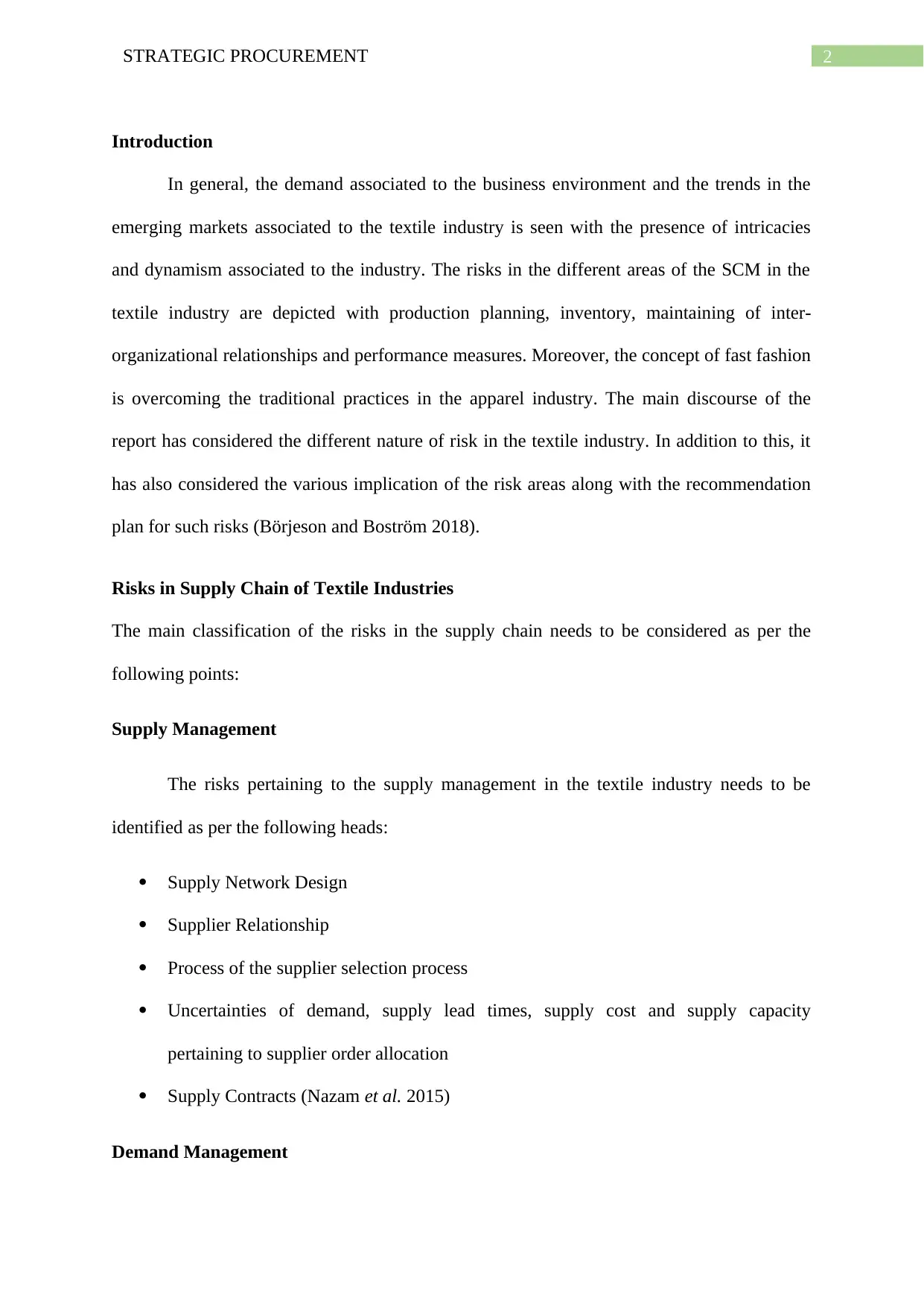
2STRATEGIC PROCUREMENT
Introduction
In general, the demand associated to the business environment and the trends in the
emerging markets associated to the textile industry is seen with the presence of intricacies
and dynamism associated to the industry. The risks in the different areas of the SCM in the
textile industry are depicted with production planning, inventory, maintaining of inter-
organizational relationships and performance measures. Moreover, the concept of fast fashion
is overcoming the traditional practices in the apparel industry. The main discourse of the
report has considered the different nature of risk in the textile industry. In addition to this, it
has also considered the various implication of the risk areas along with the recommendation
plan for such risks (Börjeson and Boström 2018).
Risks in Supply Chain of Textile Industries
The main classification of the risks in the supply chain needs to be considered as per the
following points:
Supply Management
The risks pertaining to the supply management in the textile industry needs to be
identified as per the following heads:
Supply Network Design
Supplier Relationship
Process of the supplier selection process
Uncertainties of demand, supply lead times, supply cost and supply capacity
pertaining to supplier order allocation
Supply Contracts (Nazam et al. 2015)
Demand Management
Introduction
In general, the demand associated to the business environment and the trends in the
emerging markets associated to the textile industry is seen with the presence of intricacies
and dynamism associated to the industry. The risks in the different areas of the SCM in the
textile industry are depicted with production planning, inventory, maintaining of inter-
organizational relationships and performance measures. Moreover, the concept of fast fashion
is overcoming the traditional practices in the apparel industry. The main discourse of the
report has considered the different nature of risk in the textile industry. In addition to this, it
has also considered the various implication of the risk areas along with the recommendation
plan for such risks (Börjeson and Boström 2018).
Risks in Supply Chain of Textile Industries
The main classification of the risks in the supply chain needs to be considered as per the
following points:
Supply Management
The risks pertaining to the supply management in the textile industry needs to be
identified as per the following heads:
Supply Network Design
Supplier Relationship
Process of the supplier selection process
Uncertainties of demand, supply lead times, supply cost and supply capacity
pertaining to supplier order allocation
Supply Contracts (Nazam et al. 2015)
Demand Management
⊘ This is a preview!⊘
Do you want full access?
Subscribe today to unlock all pages.

Trusted by 1+ million students worldwide
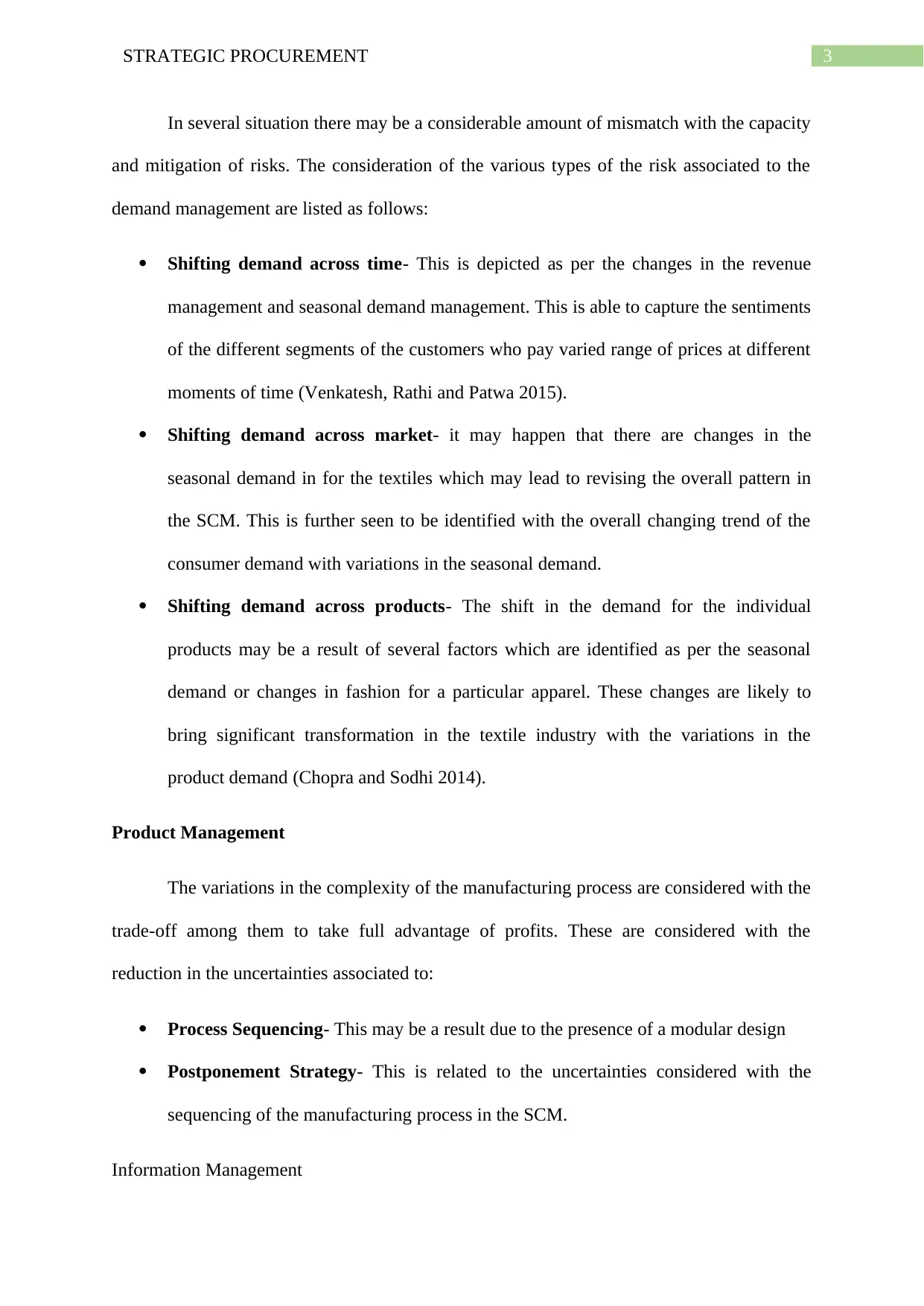
3STRATEGIC PROCUREMENT
In several situation there may be a considerable amount of mismatch with the capacity
and mitigation of risks. The consideration of the various types of the risk associated to the
demand management are listed as follows:
Shifting demand across time- This is depicted as per the changes in the revenue
management and seasonal demand management. This is able to capture the sentiments
of the different segments of the customers who pay varied range of prices at different
moments of time (Venkatesh, Rathi and Patwa 2015).
Shifting demand across market- it may happen that there are changes in the
seasonal demand in for the textiles which may lead to revising the overall pattern in
the SCM. This is further seen to be identified with the overall changing trend of the
consumer demand with variations in the seasonal demand.
Shifting demand across products- The shift in the demand for the individual
products may be a result of several factors which are identified as per the seasonal
demand or changes in fashion for a particular apparel. These changes are likely to
bring significant transformation in the textile industry with the variations in the
product demand (Chopra and Sodhi 2014).
Product Management
The variations in the complexity of the manufacturing process are considered with the
trade-off among them to take full advantage of profits. These are considered with the
reduction in the uncertainties associated to:
Process Sequencing- This may be a result due to the presence of a modular design
Postponement Strategy- This is related to the uncertainties considered with the
sequencing of the manufacturing process in the SCM.
Information Management
In several situation there may be a considerable amount of mismatch with the capacity
and mitigation of risks. The consideration of the various types of the risk associated to the
demand management are listed as follows:
Shifting demand across time- This is depicted as per the changes in the revenue
management and seasonal demand management. This is able to capture the sentiments
of the different segments of the customers who pay varied range of prices at different
moments of time (Venkatesh, Rathi and Patwa 2015).
Shifting demand across market- it may happen that there are changes in the
seasonal demand in for the textiles which may lead to revising the overall pattern in
the SCM. This is further seen to be identified with the overall changing trend of the
consumer demand with variations in the seasonal demand.
Shifting demand across products- The shift in the demand for the individual
products may be a result of several factors which are identified as per the seasonal
demand or changes in fashion for a particular apparel. These changes are likely to
bring significant transformation in the textile industry with the variations in the
product demand (Chopra and Sodhi 2014).
Product Management
The variations in the complexity of the manufacturing process are considered with the
trade-off among them to take full advantage of profits. These are considered with the
reduction in the uncertainties associated to:
Process Sequencing- This may be a result due to the presence of a modular design
Postponement Strategy- This is related to the uncertainties considered with the
sequencing of the manufacturing process in the SCM.
Information Management
Paraphrase This Document
Need a fresh take? Get an instant paraphrase of this document with our AI Paraphraser
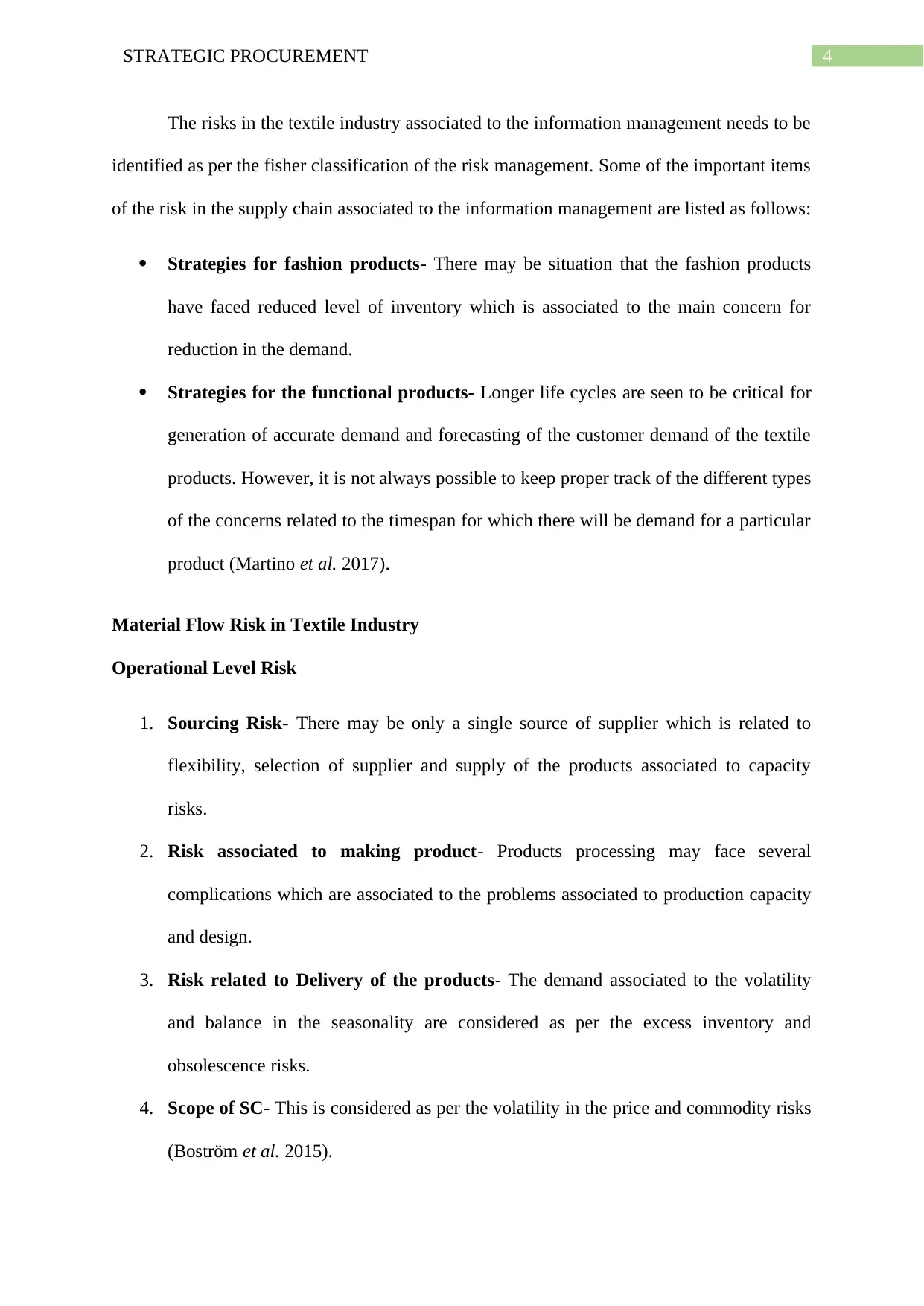
4STRATEGIC PROCUREMENT
The risks in the textile industry associated to the information management needs to be
identified as per the fisher classification of the risk management. Some of the important items
of the risk in the supply chain associated to the information management are listed as follows:
Strategies for fashion products- There may be situation that the fashion products
have faced reduced level of inventory which is associated to the main concern for
reduction in the demand.
Strategies for the functional products- Longer life cycles are seen to be critical for
generation of accurate demand and forecasting of the customer demand of the textile
products. However, it is not always possible to keep proper track of the different types
of the concerns related to the timespan for which there will be demand for a particular
product (Martino et al. 2017).
Material Flow Risk in Textile Industry
Operational Level Risk
1. Sourcing Risk- There may be only a single source of supplier which is related to
flexibility, selection of supplier and supply of the products associated to capacity
risks.
2. Risk associated to making product- Products processing may face several
complications which are associated to the problems associated to production capacity
and design.
3. Risk related to Delivery of the products- The demand associated to the volatility
and balance in the seasonality are considered as per the excess inventory and
obsolescence risks.
4. Scope of SC- This is considered as per the volatility in the price and commodity risks
(Boström et al. 2015).
The risks in the textile industry associated to the information management needs to be
identified as per the fisher classification of the risk management. Some of the important items
of the risk in the supply chain associated to the information management are listed as follows:
Strategies for fashion products- There may be situation that the fashion products
have faced reduced level of inventory which is associated to the main concern for
reduction in the demand.
Strategies for the functional products- Longer life cycles are seen to be critical for
generation of accurate demand and forecasting of the customer demand of the textile
products. However, it is not always possible to keep proper track of the different types
of the concerns related to the timespan for which there will be demand for a particular
product (Martino et al. 2017).
Material Flow Risk in Textile Industry
Operational Level Risk
1. Sourcing Risk- There may be only a single source of supplier which is related to
flexibility, selection of supplier and supply of the products associated to capacity
risks.
2. Risk associated to making product- Products processing may face several
complications which are associated to the problems associated to production capacity
and design.
3. Risk related to Delivery of the products- The demand associated to the volatility
and balance in the seasonality are considered as per the excess inventory and
obsolescence risks.
4. Scope of SC- This is considered as per the volatility in the price and commodity risks
(Boström et al. 2015).
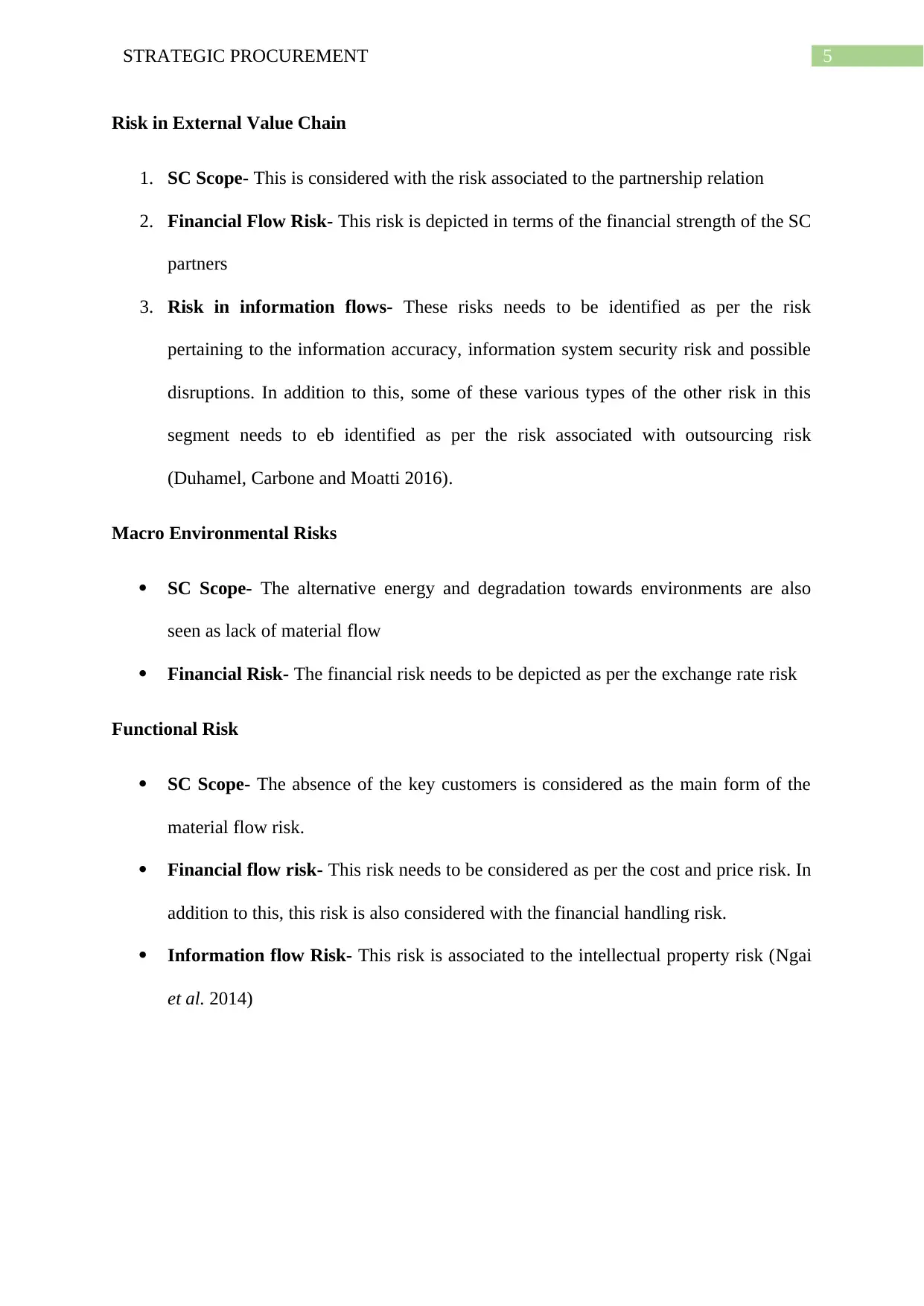
5STRATEGIC PROCUREMENT
Risk in External Value Chain
1. SC Scope- This is considered with the risk associated to the partnership relation
2. Financial Flow Risk- This risk is depicted in terms of the financial strength of the SC
partners
3. Risk in information flows- These risks needs to be identified as per the risk
pertaining to the information accuracy, information system security risk and possible
disruptions. In addition to this, some of these various types of the other risk in this
segment needs to eb identified as per the risk associated with outsourcing risk
(Duhamel, Carbone and Moatti 2016).
Macro Environmental Risks
SC Scope- The alternative energy and degradation towards environments are also
seen as lack of material flow
Financial Risk- The financial risk needs to be depicted as per the exchange rate risk
Functional Risk
SC Scope- The absence of the key customers is considered as the main form of the
material flow risk.
Financial flow risk- This risk needs to be considered as per the cost and price risk. In
addition to this, this risk is also considered with the financial handling risk.
Information flow Risk- This risk is associated to the intellectual property risk (Ngai
et al. 2014)
Risk in External Value Chain
1. SC Scope- This is considered with the risk associated to the partnership relation
2. Financial Flow Risk- This risk is depicted in terms of the financial strength of the SC
partners
3. Risk in information flows- These risks needs to be identified as per the risk
pertaining to the information accuracy, information system security risk and possible
disruptions. In addition to this, some of these various types of the other risk in this
segment needs to eb identified as per the risk associated with outsourcing risk
(Duhamel, Carbone and Moatti 2016).
Macro Environmental Risks
SC Scope- The alternative energy and degradation towards environments are also
seen as lack of material flow
Financial Risk- The financial risk needs to be depicted as per the exchange rate risk
Functional Risk
SC Scope- The absence of the key customers is considered as the main form of the
material flow risk.
Financial flow risk- This risk needs to be considered as per the cost and price risk. In
addition to this, this risk is also considered with the financial handling risk.
Information flow Risk- This risk is associated to the intellectual property risk (Ngai
et al. 2014)
⊘ This is a preview!⊘
Do you want full access?
Subscribe today to unlock all pages.

Trusted by 1+ million students worldwide
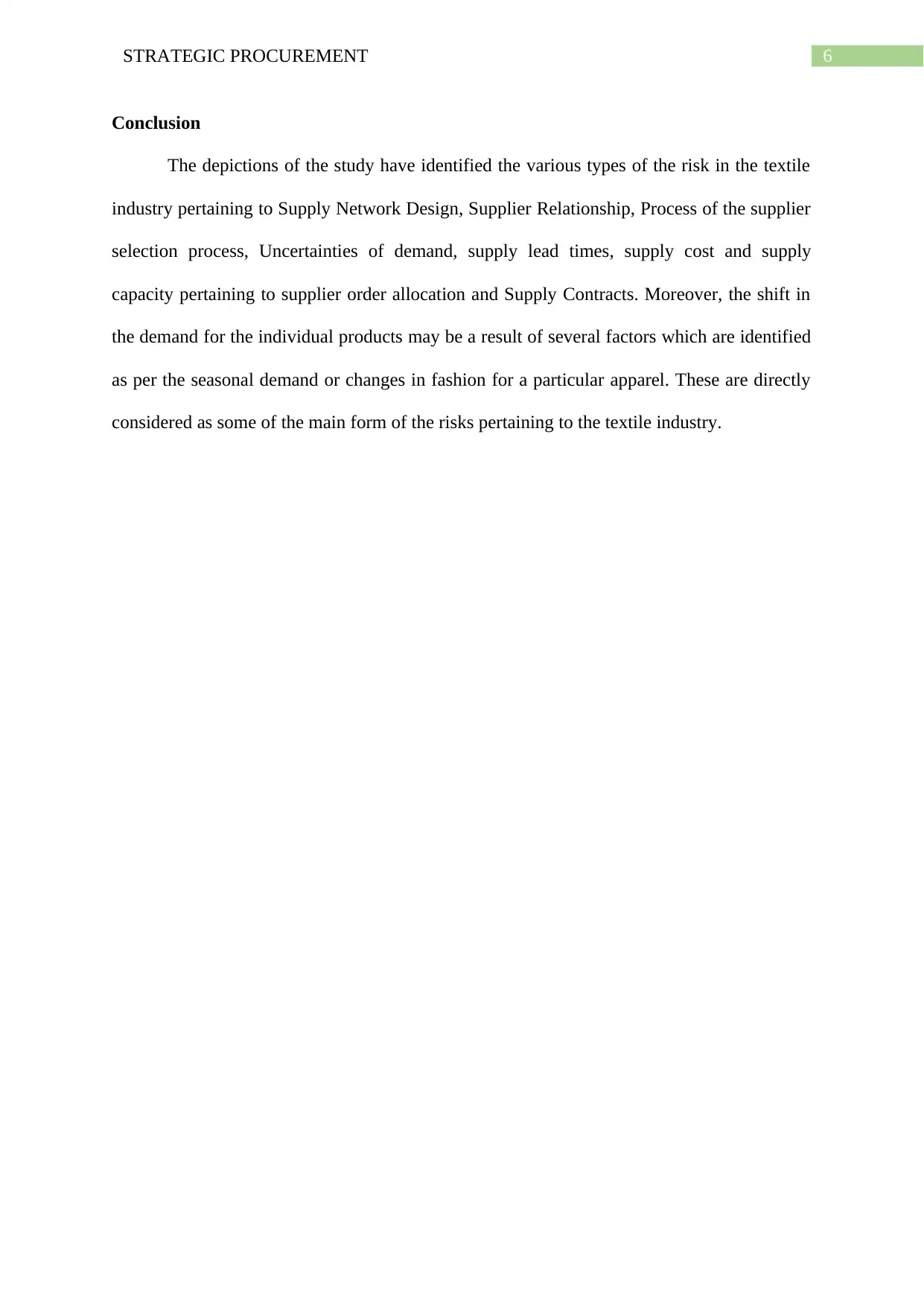
6STRATEGIC PROCUREMENT
Conclusion
The depictions of the study have identified the various types of the risk in the textile
industry pertaining to Supply Network Design, Supplier Relationship, Process of the supplier
selection process, Uncertainties of demand, supply lead times, supply cost and supply
capacity pertaining to supplier order allocation and Supply Contracts. Moreover, the shift in
the demand for the individual products may be a result of several factors which are identified
as per the seasonal demand or changes in fashion for a particular apparel. These are directly
considered as some of the main form of the risks pertaining to the textile industry.
Conclusion
The depictions of the study have identified the various types of the risk in the textile
industry pertaining to Supply Network Design, Supplier Relationship, Process of the supplier
selection process, Uncertainties of demand, supply lead times, supply cost and supply
capacity pertaining to supplier order allocation and Supply Contracts. Moreover, the shift in
the demand for the individual products may be a result of several factors which are identified
as per the seasonal demand or changes in fashion for a particular apparel. These are directly
considered as some of the main form of the risks pertaining to the textile industry.
Paraphrase This Document
Need a fresh take? Get an instant paraphrase of this document with our AI Paraphraser
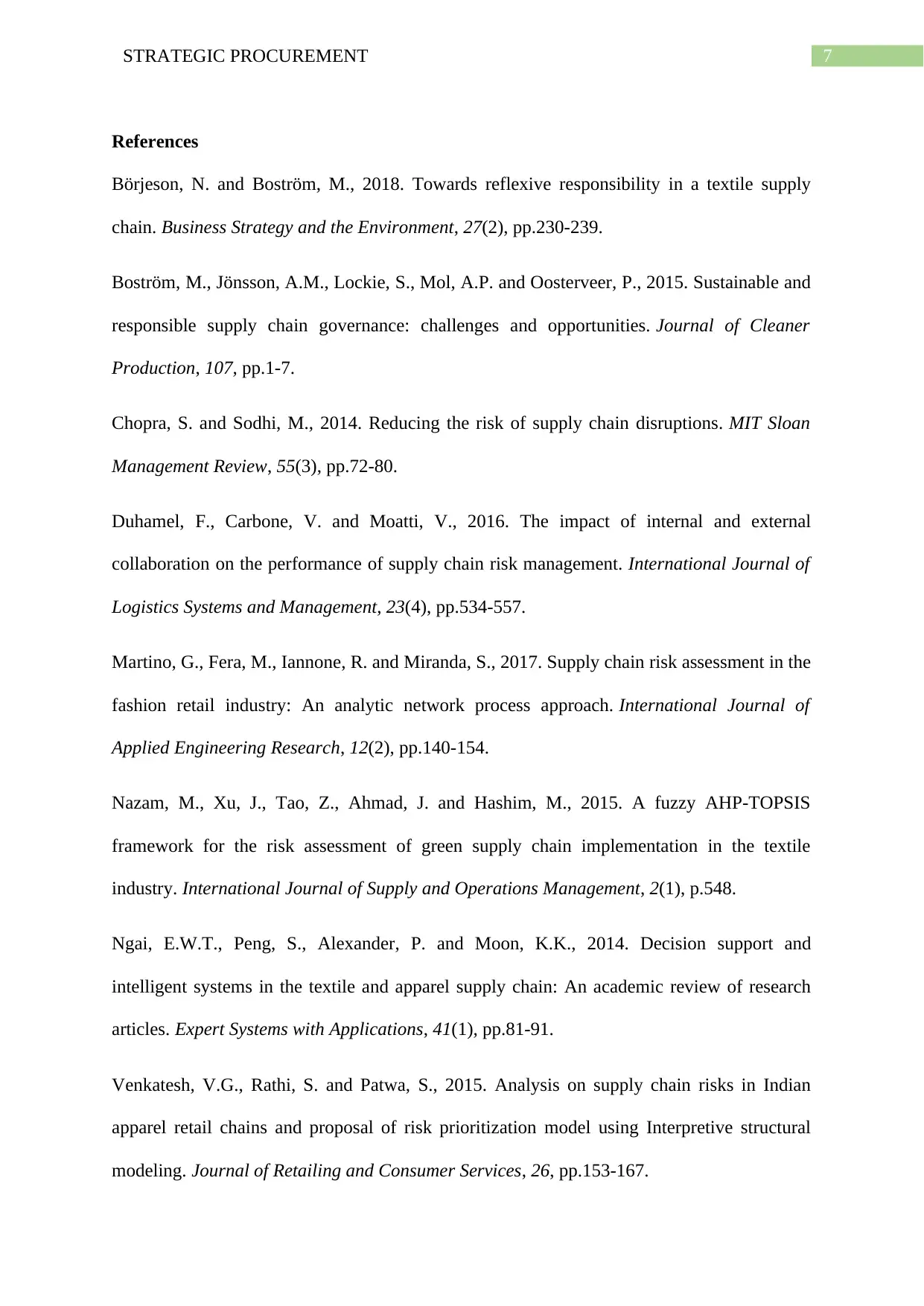
7STRATEGIC PROCUREMENT
References
Börjeson, N. and Boström, M., 2018. Towards reflexive responsibility in a textile supply
chain. Business Strategy and the Environment, 27(2), pp.230-239.
Boström, M., Jönsson, A.M., Lockie, S., Mol, A.P. and Oosterveer, P., 2015. Sustainable and
responsible supply chain governance: challenges and opportunities. Journal of Cleaner
Production, 107, pp.1-7.
Chopra, S. and Sodhi, M., 2014. Reducing the risk of supply chain disruptions. MIT Sloan
Management Review, 55(3), pp.72-80.
Duhamel, F., Carbone, V. and Moatti, V., 2016. The impact of internal and external
collaboration on the performance of supply chain risk management. International Journal of
Logistics Systems and Management, 23(4), pp.534-557.
Martino, G., Fera, M., Iannone, R. and Miranda, S., 2017. Supply chain risk assessment in the
fashion retail industry: An analytic network process approach. International Journal of
Applied Engineering Research, 12(2), pp.140-154.
Nazam, M., Xu, J., Tao, Z., Ahmad, J. and Hashim, M., 2015. A fuzzy AHP-TOPSIS
framework for the risk assessment of green supply chain implementation in the textile
industry. International Journal of Supply and Operations Management, 2(1), p.548.
Ngai, E.W.T., Peng, S., Alexander, P. and Moon, K.K., 2014. Decision support and
intelligent systems in the textile and apparel supply chain: An academic review of research
articles. Expert Systems with Applications, 41(1), pp.81-91.
Venkatesh, V.G., Rathi, S. and Patwa, S., 2015. Analysis on supply chain risks in Indian
apparel retail chains and proposal of risk prioritization model using Interpretive structural
modeling. Journal of Retailing and Consumer Services, 26, pp.153-167.
References
Börjeson, N. and Boström, M., 2018. Towards reflexive responsibility in a textile supply
chain. Business Strategy and the Environment, 27(2), pp.230-239.
Boström, M., Jönsson, A.M., Lockie, S., Mol, A.P. and Oosterveer, P., 2015. Sustainable and
responsible supply chain governance: challenges and opportunities. Journal of Cleaner
Production, 107, pp.1-7.
Chopra, S. and Sodhi, M., 2014. Reducing the risk of supply chain disruptions. MIT Sloan
Management Review, 55(3), pp.72-80.
Duhamel, F., Carbone, V. and Moatti, V., 2016. The impact of internal and external
collaboration on the performance of supply chain risk management. International Journal of
Logistics Systems and Management, 23(4), pp.534-557.
Martino, G., Fera, M., Iannone, R. and Miranda, S., 2017. Supply chain risk assessment in the
fashion retail industry: An analytic network process approach. International Journal of
Applied Engineering Research, 12(2), pp.140-154.
Nazam, M., Xu, J., Tao, Z., Ahmad, J. and Hashim, M., 2015. A fuzzy AHP-TOPSIS
framework for the risk assessment of green supply chain implementation in the textile
industry. International Journal of Supply and Operations Management, 2(1), p.548.
Ngai, E.W.T., Peng, S., Alexander, P. and Moon, K.K., 2014. Decision support and
intelligent systems in the textile and apparel supply chain: An academic review of research
articles. Expert Systems with Applications, 41(1), pp.81-91.
Venkatesh, V.G., Rathi, S. and Patwa, S., 2015. Analysis on supply chain risks in Indian
apparel retail chains and proposal of risk prioritization model using Interpretive structural
modeling. Journal of Retailing and Consumer Services, 26, pp.153-167.
1 out of 8
Related Documents
Your All-in-One AI-Powered Toolkit for Academic Success.
+13062052269
info@desklib.com
Available 24*7 on WhatsApp / Email
![[object Object]](/_next/static/media/star-bottom.7253800d.svg)
Unlock your academic potential
Copyright © 2020–2025 A2Z Services. All Rights Reserved. Developed and managed by ZUCOL.





